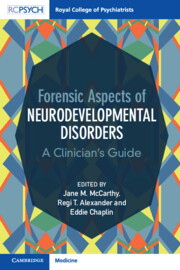Book contents
- Forensic Aspects of Neurodevelopmental Disorders
- Forensic Aspects of Neurodevelopmental Disorders
- Copyright page
- About the Cover Page
- Contents
- Contributors
- Foreword by the Rt Hon Lord Bradley
- Terminology Used in the Book
- Section 1 An Overview: Definitions, Epidemiology and Policy Issues
- Chapter 1 Introduction
- Chapter 2 Aetiology of Neurodevelopmental Disorders
- Chapter 3 Overview of Offenders with Intellectual Disability
- Chapter 4 Overview of Offenders with Attention Deficit Hyperactivity Disorder
- Chapter 5 Overview of Offenders with Autism Spectrum Disorder
- Chapter 6 Associations between Autism Spectrum Disorder and Types of Offences
- Chapter 7 Overview of Young People with Neurodevelopmental Impairments in Contact with the Youth Justice System
- Chapter 8 Overview of Offenders with Fetal Alcohol Spectrum Disorders
- Chapter 9 The Role of Subthreshold Neurodevelopmental Disorder in Offending Behaviour
- Chapter 10 Comorbid Mental Disorders and Neurodevelopmental Conditions
- Section 2 Assessment and Therapeutic Approach
- Section 3 Criminal Justice Pathways and Legal Issues
- Index
- References
Chapter 6 - Associations between Autism Spectrum Disorder and Types of Offences
from Section 1 - An Overview: Definitions, Epidemiology and Policy Issues
Published online by Cambridge University Press: 18 May 2023
- Forensic Aspects of Neurodevelopmental Disorders
- Forensic Aspects of Neurodevelopmental Disorders
- Copyright page
- About the Cover Page
- Contents
- Contributors
- Foreword by the Rt Hon Lord Bradley
- Terminology Used in the Book
- Section 1 An Overview: Definitions, Epidemiology and Policy Issues
- Chapter 1 Introduction
- Chapter 2 Aetiology of Neurodevelopmental Disorders
- Chapter 3 Overview of Offenders with Intellectual Disability
- Chapter 4 Overview of Offenders with Attention Deficit Hyperactivity Disorder
- Chapter 5 Overview of Offenders with Autism Spectrum Disorder
- Chapter 6 Associations between Autism Spectrum Disorder and Types of Offences
- Chapter 7 Overview of Young People with Neurodevelopmental Impairments in Contact with the Youth Justice System
- Chapter 8 Overview of Offenders with Fetal Alcohol Spectrum Disorders
- Chapter 9 The Role of Subthreshold Neurodevelopmental Disorder in Offending Behaviour
- Chapter 10 Comorbid Mental Disorders and Neurodevelopmental Conditions
- Section 2 Assessment and Therapeutic Approach
- Section 3 Criminal Justice Pathways and Legal Issues
- Index
- References
Summary
Although individuals with an Autism Spectrum Disorder (ASD) have been associated with many types of offences, some appear to be particularly problematic such as those involving cybercrime, interpersonal violence, arson and firesetting, terrorism, stalking, as well as some sexual offences. Clinical experience and research suggest that whilst individual motivations for offending may vary, an understanding of why these offences occur among individuals with an ASD should be informed by the associated difficulties and vulnerabilities. However, an understanding of ASD and the associated difficulties within the courts remains varied, raising questions around the important role experts play in trials involving individuals with an ASD.
- Type
- Chapter
- Information
- Forensic Aspects of Neurodevelopmental DisordersA Clinician's Guide, pp. 56 - 70Publisher: Cambridge University PressPrint publication year: 2023



